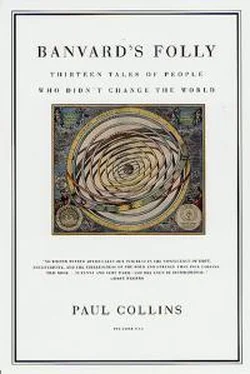Charpentier's results were quickly confirmed in England by Drs. Hugh Walsham and Leslie Miller. They invited the editors of the medical journal The Lancet to observe the brightening of a wiggling thumb under the screen; the editors were duly impressed by the results. "There would no longer appear to be any doubt," they wrote in the February 20, 1904, issue, "that rays are given off by active muscles and nerves." Not that every Lancet writer was possessed of such indisputable genius; an adjacent column from an aptly named Dr. White made the curious claim that "among the North American Indians insanity is of rare occurrence ... because they live an easygoing outdoor life free from care and worry for the future and therefore free from mental overstrain."
Still, Professor Charpentier's work had raised an interesting idea--that an entire unseen world of the human nervous system would now be visible with n-ray technology. "This effect," marveled the journal Nature, "may prove of the greatest importance in the case of nerves." What X-rays were just starting to do for the observation of organs and bones, n-rays could now do for brain matter and muscles. They could even help diagnose disease; in March 1904, Gilbert Ballet of the French Academy discovered that specific ailments like spastic paraplegia produced unique n-ray patterns. Meanwhile, a neurologist in Edinburgh pondered the notion of detecting brain tumors through n-ray patterns made by the brain. The miraculous diagnostic tool of brain scans, a concept that had been beyond the range of thinkable thoughts before, now opened itself to those who could develop this technology.
It made sense that medical doctors would be the most interested in the discovery of n-rays, for at the turn of the century doctors were bombarding hapless patients with every variety of radiation available; as soon as a new wavelength was discovered, doctors built lamps to generate it, and then joyfully zapped gouty joints, tubercular lungs, syphilitic brain tissue, and anything else that happened to venture into their waiting rooms. It was known that ultraviolet light helped clear up smallpox pustules, that infrared could soothe injured muscles, and that gamma radiation might shrink tumors ... so why not try n-rays?
Many English scientists, though, were lagging dreadfully behind their French colleagues. The journal Nature received letters and articles almost every
month in 1904 from scientists complaining that no matter how hard they squinted, they simply couldn't catch a glimpse of n-rays hitting their calcium sulfide screens. A few even sourly suggested that n-rays weren't put out by the body at all; rather, it was body heat that made the screen fluoresce. S.
G. Brown of London noted in the January 28 issue:
About three months ago, I independently discovered that a feebly luminous phosphorescent zinc sulfide screen when brought near the body increased in brightness. ... [Perhaps] heat was the cause of the phenomenon. Further trials showed this to be the case; by laying the back of the screen against a fluted jar filled with warm water the zinc sulfide would brighten up.
A month later, London physicist A. A. Swinton wrote a long letter to Nature about his own experiments--he found that a warm coin could produce the same effect. Put your foot near the screen, and it might fluoresce with n-rays, but when you took your foot out of your boot and just left the still-warm boot behind, the screen still fluoresced. What the French were seeing on their screens, Swinton warned, was just heat. The fact that n-rays only gradually appeared on the screen was especially damning to Swinton--after all, he said, most thermal effects also take a while to appear.
Even so, these writers were careful not to dismiss n-rays out of hand. "One can scarcely believe that a man of science of M. Blondlot's antecedents and experiences can have deceived himself," Swinton vouched. And the argument over heat quieted down a little when Hugh Walsham and Leslie Miller, writing again in The Lancet, found that heat did indeed affect the screens--but that after you insulated the screens from heat, they still glowed in the presence of muscle contractions and nerve activity.
Wishing to settle the matter once and for all, the Lancet editors tried it out in their offices one day that February. They reported, "By simply placing a speck of recently excited calcium sulfide on a thick book--such as, for example, the Medical Directory--a distinct increase in the glow is obvious when the muscles of the hand or leg are contracted underneath."
Back in France, n-rays were consuming Blondlot's life, and throughout 1904 he was publishing papers in Comptes Rendus at a staggering rate. Every month saw a new paper, complete with diagrams and photographic plates. Nor was he alone: in the first half of 1904, Comptes Rendus published fifty-four papers on n-rays. During that same period, it published only three papers on X-rays. And the import of the discoveries was no longer about the basic nature of the rays themselves --that had been well established. Now scientists were pushing into the effect of the rays on human subjects, with Blondlot himself as one willing subject.
Closing the shutters of his laboratory one cold day, Blondlot sat in the darkness and waited for his eyes to acclimate. Even so, he could scarcely see his hands in front of his face, nor the clock on his lab's wall.
He exposed his eyes to a chunk of n-radioactive material.
Slowly, and to his amazement, his hands became visible in front of him. The clock on the wall became clearer: at first he saw the clock face turning whiter. But the clock was a full twelve feet away--he couldn't possibly see it from here. Then he saw its circular outline emerge from the darkness. And then--this in near pitch darkness-he could see the hand of the clock.
Others rushed to experiment with the effect of n-rays on the human senses, and published reports verified Blondlot's results. Not only did vision sharpen with exposure to n-rays, so did all the other senses. Professor Charpentier
continued his experiments well into the spring, beaming n-rays at humans and at the spinal columns of unfortunate dogs and frogs. He found that exposing the tongue, the nasal membrane, and the inner ear to radioactive material made them more acutely sensitive. Firing n-rays at the frontal lobe of the brain also did the trick--a beam of n-rays directed at the glabella or the bregma, for example, would make a subject suddenly aware of hitherto indiscernible smells. Irradiate the seventh cervical vertebra, and you could make the pupils of the eye contract.
Another physicist, Jean Becquerel, found that the drug digitalis emitted n-rays, but only in the presence of a beating heart. Something about the heart caused the digitalis solution to radiate. Anesthetic drugs like chloroform, on the other hand, could cause organic and inorganic materials alike to stop emitting n-rays. With a bit of ether, you could "anesthetize" a chunk of metal to make it stop emitting n-rays. So the secret of the efficacy of drugs, some speculated, might have little to do with the chemical content--it lay in their tendency to accumulate in certain parts of the body, where they would then irradiate tissue with n-rays, or cause the tissues to stop radiating.
But others were simply not convinced. C. C. Schenk, a Canadian physicist at McGill University, archly commented in Nature about Blondlot's ability to make exacting wavelength measurements "with a radiation so feeble that no one outside of France has been able to detect it at all." Others wondered aloud whether France was in the grip of a spell of self-hypnosis. Furthermore, not all of Blondlot's supporters were entirely reputable. A variety of cranks had written Blondlot and others in 1904, claiming that they had discovered n-rays years before, and loony experiments with unfortunate live subjects abounded.
Читать дальше











